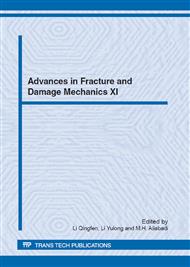p.389
p.393
p.397
p.401
p.405
p.409
p.413
p.417
p.421
Analysis of Crack Arrest by Electromagnetic Heating in Metal with Oblique-Elliptical Embedding Crack
Abstract:
Ellipse crack tip can be passivated when pulse current is perpendicular to crack surface of metal structure which can achieve the purpose of crack. In practice, it is hard that the loading current direction perpendicular to the crack surface because of the crack existence of different position and orientation. Theory and numerical simulation analyze the effect of crack arrest by electromagnetic heating based on metal structure with oblique-elliptical embedding crack. And current density and temperature distribution of crack tip are derived. The result shows that due to heat concentration around the oblique-elliptical embedding crack tip, the crack tip temperature exceeds the melting point of materials and small welded joints are formed by metal melting. Thermal compressive stress which is generated near the crack tip can prevent the crack propagation effectively. Thus, electromagnetic heating is proved to be an effective method of preventing general crack propagation.
Info:
Periodical:
Pages:
405-408
Citation:
Online since:
November 2012
Authors:
Price:
Сopyright:
© 2013 Trans Tech Publications Ltd. All Rights Reserved
Share:
Citation:


